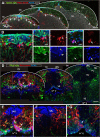Development and specification of cerebellar stem and progenitor cells in zebrafish: from embryo to adult
- PMID: 23641971
- PMCID: PMC3685596
- DOI: 10.1186/1749-8104-8-9
Development and specification of cerebellar stem and progenitor cells in zebrafish: from embryo to adult
Abstract
Background: Teleost fish display widespread post-embryonic neurogenesis originating from many different proliferative niches that are distributed along the brain axis. During the development of the central nervous system (CNS) different cell types are produced in a strict temporal order from increasingly committed progenitors. However, it is not known whether diverse neural stem and progenitor cell types with restricted potential or stem cells with broad potential are maintained in the teleost fish brain.
Results: To study the diversity and output of neural stem and progenitor cell populations in the zebrafish brain the cerebellum was used as a model brain region, because of its well-known architecture and development. Transgenic zebrafish lines, in vivo imaging and molecular markers were used to follow and quantify how the proliferative activity and output of cerebellar progenitor populations progress. This analysis revealed that the proliferative activity and progenitor marker expression declines in juvenile zebrafish before they reach sexual maturity. Furthermore, this correlated with the diminished repertoire of cell types produced in the adult. The stem and progenitor cells derived from the upper rhombic lip were maintained into adulthood and they actively produced granule cells. Ventricular zone derived progenitor cells were largely quiescent in the adult cerebellum and produced a very limited number of glia and inhibitory inter-neurons. No Purkinje or Eurydendroid cells were produced in fish older than 3 months. This suggests that cerebellar cell types are produced in a strict temporal order from distinct pools of increasingly committed stem and progenitor cells.
Conclusions: Our results in the zebrafish cerebellum show that neural stem and progenitor cell types are specified and they produce distinct cell lineages and sub-types of brain cells. We propose that only specific subtypes of brain cells are continuously produced throughout life in the teleost fish brain. This implies that the post-embryonic neurogenesis in fish is linked to the production of particular neurons involved in specific brain functions, rather than to general, indeterminate growth of the CNS and all of its cell types.
Figures









Similar articles
-
Absence of an external germinal layer in zebrafish and shark reveals a distinct, anamniote ground plan of cerebellum development.J Neurosci. 2010 Feb 24;30(8):3048-57. doi: 10.1523/JNEUROSCI.6201-09.2010. J Neurosci. 2010. PMID: 20181601 Free PMC article.
-
Antagonism between Notch and bone morphogenetic protein receptor signaling regulates neurogenesis in the cerebellar rhombic lip.Neural Dev. 2007 Feb 23;2:5. doi: 10.1186/1749-8104-2-5. Neural Dev. 2007. PMID: 17319963 Free PMC article.
-
Proneural gene-linked neurogenesis in zebrafish cerebellum.Dev Biol. 2010 Jul 1;343(1-2):1-17. doi: 10.1016/j.ydbio.2010.03.024. Epub 2010 Apr 11. Dev Biol. 2010. PMID: 20388506
-
Development of the cerebellum and cerebellar neural circuits.Dev Neurobiol. 2012 Mar;72(3):282-301. doi: 10.1002/dneu.20875. Dev Neurobiol. 2012. PMID: 21309081 Review.
-
Development and evolution of cerebellar neural circuits.Dev Growth Differ. 2012 Apr;54(3):373-89. doi: 10.1111/j.1440-169X.2012.01348.x. Dev Growth Differ. 2012. PMID: 22524607 Review.
Cited by
-
Maintenance of somatic tissue regeneration with age in short- and long-lived species of sea urchins.Aging Cell. 2016 Aug;15(4):778-87. doi: 10.1111/acel.12487. Epub 2016 Apr 20. Aging Cell. 2016. PMID: 27095483 Free PMC article.
-
Genetic modeling of degenerative diseases and mechanisms of neuronal regeneration in the zebrafish cerebellum.Cell Mol Life Sci. 2024 Dec 27;82(1):26. doi: 10.1007/s00018-024-05538-z. Cell Mol Life Sci. 2024. PMID: 39725709 Free PMC article. Review.
-
Adult Hippocampal Neurogenesis in Different Taxonomic Groups: Possible Functional Similarities and Striking Controversies.Cells. 2019 Feb 5;8(2):125. doi: 10.3390/cells8020125. Cells. 2019. PMID: 30764477 Free PMC article. Review.
-
Age-Dependent Regulation of Notch Family Members in the Neuronal Stem Cell Niches of the Short-Lived Killifish Nothobranchius furzeri.Front Cell Dev Biol. 2021 Jul 9;9:640958. doi: 10.3389/fcell.2021.640958. eCollection 2021. Front Cell Dev Biol. 2021. PMID: 34307342 Free PMC article.
-
Pcgf1 Regulates Early Neural Tube Development Through Histone Methylation in Zebrafish.Front Cell Dev Biol. 2021 Jan 26;8:581636. doi: 10.3389/fcell.2020.581636. eCollection 2020. Front Cell Dev Biol. 2021. PMID: 33575252 Free PMC article.
References
-
- Merkle FT, Mirzadeh Z, Alvarez-Buylla A. Mosaic organization of neural stem cells in the adult brain. Science. 2007;317:381–384. - PubMed
-
- Hack MA, Saghatelyan A, de Chevigny A, Pfeifer A, Ashery-Padan R, Lledo PM, Gotz M. Neuronal fate determinants of adult olfactory bulb neurogenesis. Nat Neurosci. 2005;8:865–872. - PubMed
-
- Shen Q, Wang Y, Dimos JT, Fasano CA, Phoenix TN, Lemischka IR, Ivanova NB, Stifani S, Morrisey EE, Temple S. The timing of cortical neurogenesis is encoded within lineages of individual progenitor cells. Nat Neurosci. 2006;9:743–751. - PubMed
Publication types
MeSH terms
LinkOut - more resources
Full Text Sources
Other Literature Sources
Medical
Molecular Biology Databases

